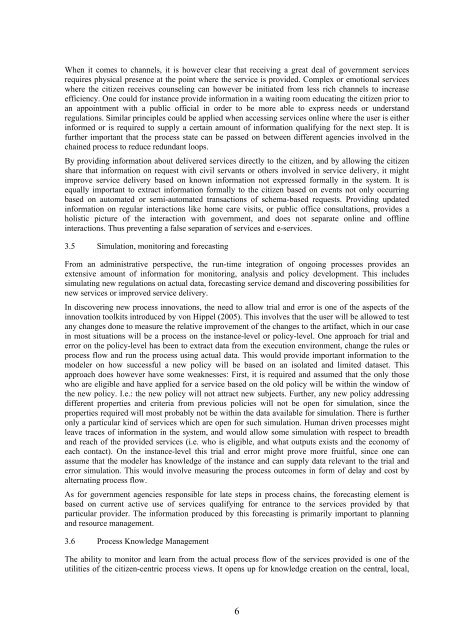Multi-channel provisioning of public services - Department of ...
Multi-channel provisioning of public services - Department of ...
Multi-channel provisioning of public services - Department of ...
You also want an ePaper? Increase the reach of your titles
YUMPU automatically turns print PDFs into web optimized ePapers that Google loves.
When it comes to <strong>channel</strong>s, it is however clear that receiving a great deal <strong>of</strong> government <strong>services</strong><br />
requires physical presence at the point where the service is provided. Complex or emotional <strong>services</strong><br />
where the citizen receives counseling can however be initiated from less rich <strong>channel</strong>s to increase<br />
efficiency. One could for instance provide information in a waiting room educating the citizen prior to<br />
an appointment with a <strong>public</strong> <strong>of</strong>ficial in order to be more able to express needs or understand<br />
regulations. Similar principles could be applied when accessing <strong>services</strong> online where the user is either<br />
informed or is required to supply a certain amount <strong>of</strong> information qualifying for the next step. It is<br />
further important that the process state can be passed on between different agencies involved in the<br />
chained process to reduce redundant loops.<br />
By providing information about delivered <strong>services</strong> directly to the citizen, and by allowing the citizen<br />
share that information on request with civil servants or others involved in service delivery, it might<br />
improve service delivery based on known information not expressed formally in the system. It is<br />
equally important to extract information formally to the citizen based on events not only occurring<br />
based on automated or semi-automated transactions <strong>of</strong> schema-based requests. Providing updated<br />
information on regular interactions like home care visits, or <strong>public</strong> <strong>of</strong>fice consultations, provides a<br />
holistic picture <strong>of</strong> the interaction with government, and does not separate online and <strong>of</strong>fline<br />
interactions. Thus preventing a false separation <strong>of</strong> <strong>services</strong> and e-<strong>services</strong>.<br />
3.5 Simulation, monitoring and forecasting<br />
From an administrative perspective, the run-time integration <strong>of</strong> ongoing processes provides an<br />
extensive amount <strong>of</strong> information for monitoring, analysis and policy development. This includes<br />
simulating new regulations on actual data, forecasting service demand and discovering possibilities for<br />
new <strong>services</strong> or improved service delivery.<br />
In discovering new process innovations, the need to allow trial and error is one <strong>of</strong> the aspects <strong>of</strong> the<br />
innovation toolkits introduced by von Hippel (2005). This involves that the user will be allowed to test<br />
any changes done to measure the relative improvement <strong>of</strong> the changes to the artifact, which in our case<br />
in most situations will be a process on the instance-level or policy-level. One approach for trial and<br />
error on the policy-level has been to extract data from the execution environment, change the rules or<br />
process flow and run the process using actual data. This would provide important information to the<br />
modeler on how successful a new policy will be based on an isolated and limited dataset. This<br />
approach does however have some weaknesses: First, it is required and assumed that the only those<br />
who are eligible and have applied for a service based on the old policy will be within the window <strong>of</strong><br />
the new policy. I.e.: the new policy will not attract new subjects. Further, any new policy addressing<br />
different properties and criteria from previous policies will not be open for simulation, since the<br />
properties required will most probably not be within the data available for simulation. There is further<br />
only a particular kind <strong>of</strong> <strong>services</strong> which are open for such simulation. Human driven processes might<br />
leave traces <strong>of</strong> information in the system, and would allow some simulation with respect to breadth<br />
and reach <strong>of</strong> the provided <strong>services</strong> (i.e. who is eligible, and what outputs exists and the economy <strong>of</strong><br />
each contact). On the instance-level this trial and error might prove more fruitful, since one can<br />
assume that the modeler has knowledge <strong>of</strong> the instance and can supply data relevant to the trial and<br />
error simulation. This would involve measuring the process outcomes in form <strong>of</strong> delay and cost by<br />
alternating process flow.<br />
As for government agencies responsible for late steps in process chains, the forecasting element is<br />
based on current active use <strong>of</strong> <strong>services</strong> qualifying for entrance to the <strong>services</strong> provided by that<br />
particular provider. The information produced by this forecasting is primarily important to planning<br />
and resource management.<br />
3.6 Process Knowledge Management<br />
The ability to monitor and learn from the actual process flow <strong>of</strong> the <strong>services</strong> provided is one <strong>of</strong> the<br />
utilities <strong>of</strong> the citizen-centric process views. It opens up for knowledge creation on the central, local,<br />
6
















